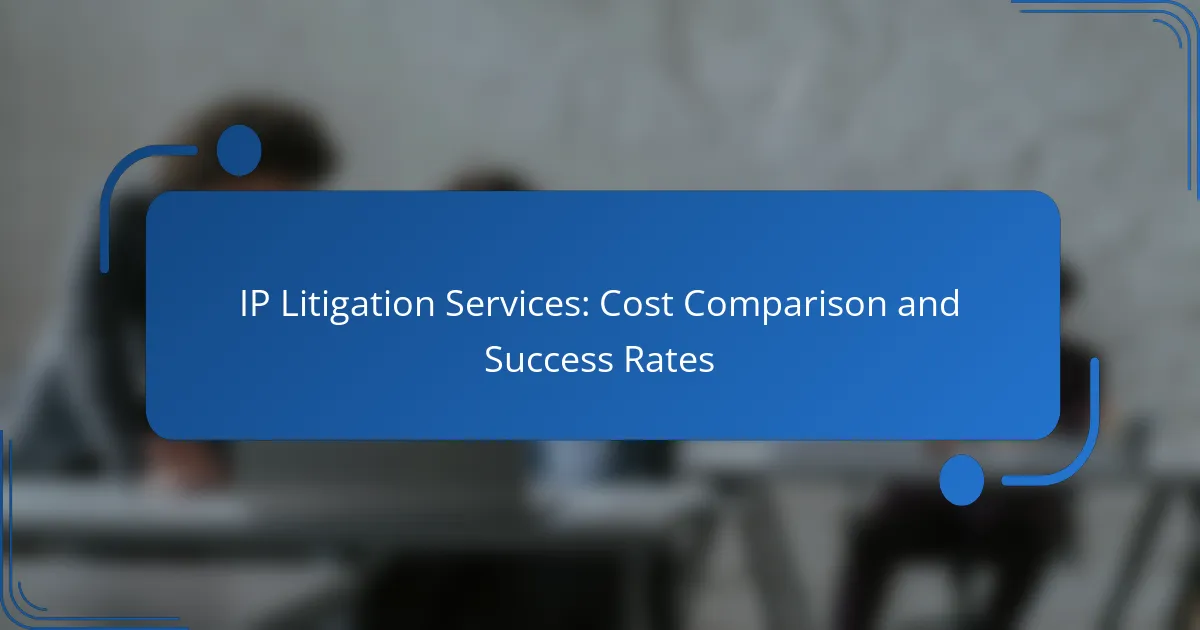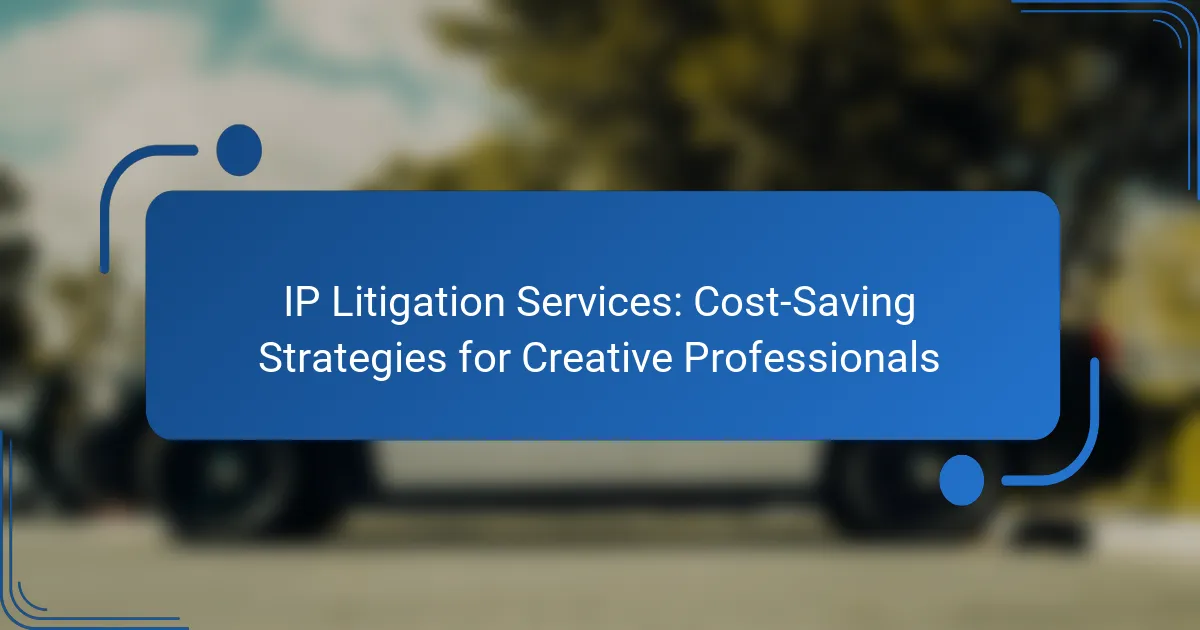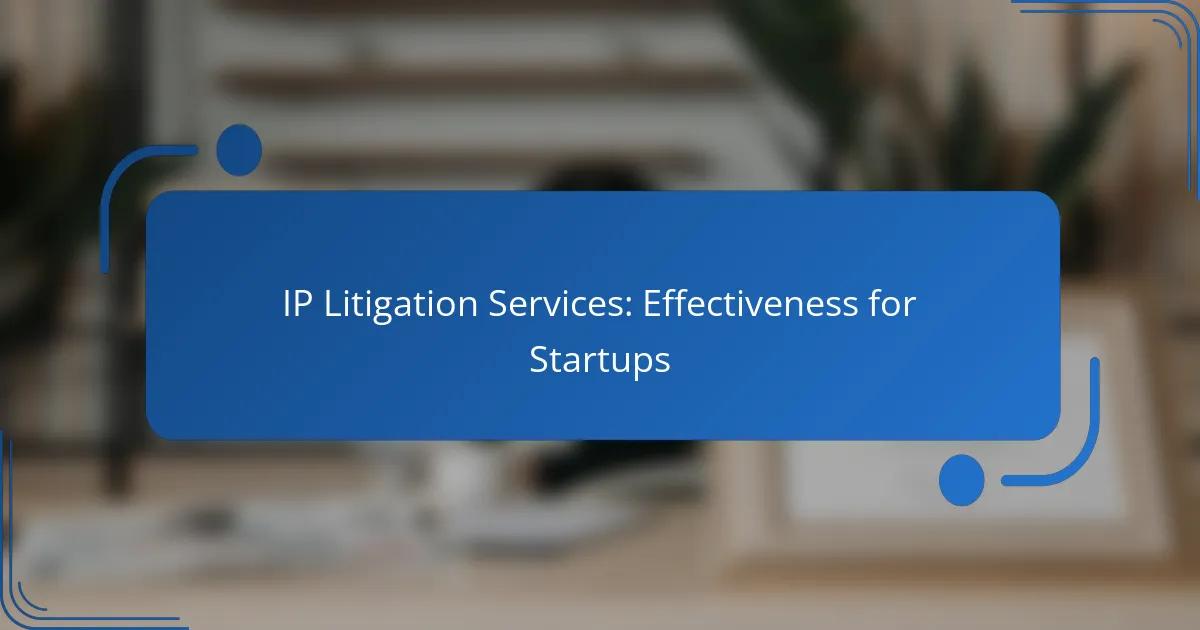Understanding the costs and success rates associated with IP litigation services is essential for anyone navigating intellectual property disputes. Costs can fluctuate widely based on factors like attorney fees and regional differences, while success rates often depend on the type of intellectual property involved. By comparing these elements, businesses and individuals can make informed decisions about their legal strategies.
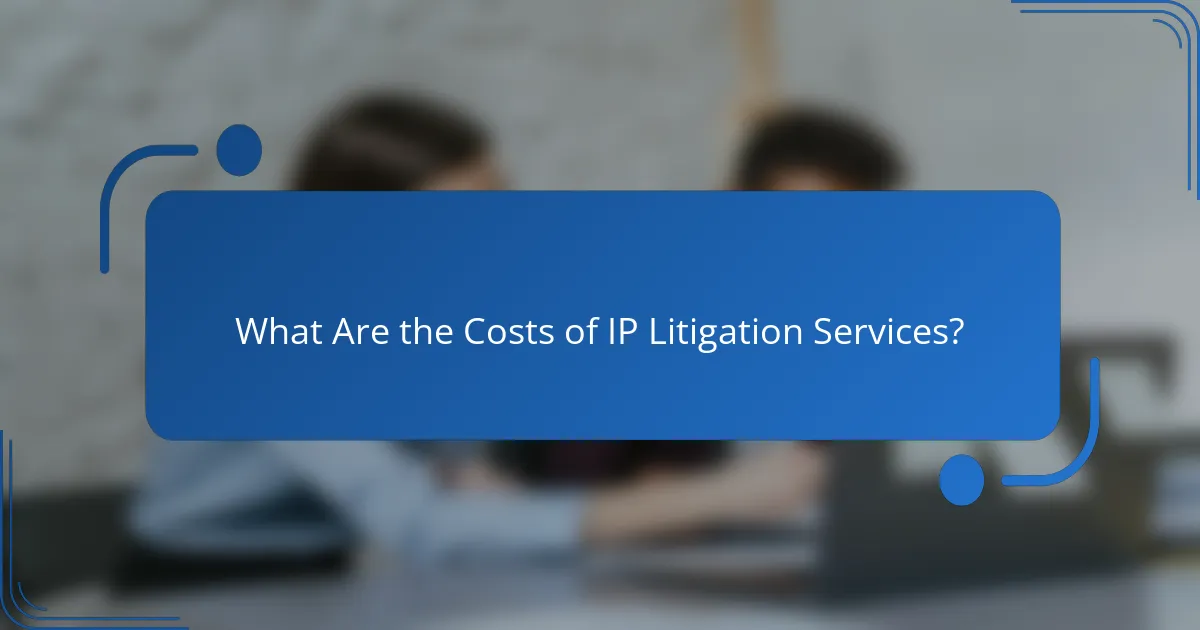
What Are the Costs of IP Litigation Services?
The costs of IP litigation services can vary significantly based on several factors, including attorney fees, retainer agreements, and regional differences. Understanding these costs is crucial for businesses and individuals involved in intellectual property disputes.
Average hourly rates of IP attorneys
The average hourly rates for IP attorneys typically range from $200 to $600, depending on their experience and expertise. Senior attorneys or those at prestigious firms may charge higher rates, while less experienced attorneys might offer lower fees.
When selecting an attorney, consider their track record in IP litigation, as a higher rate may be justified by a history of successful outcomes. It’s advisable to request a detailed fee structure upfront to avoid surprises later.
Typical retainer fees
Retainer fees for IP litigation can vary widely, often falling between $5,000 and $50,000. This upfront payment secures the attorney’s services and is typically applied against future billable hours.
It’s essential to clarify what the retainer covers and how often you can expect to replenish it. Some attorneys may require additional funds as the case progresses, so ensure you have a clear understanding of the financial commitments involved.
Cost variations by region
Costs for IP litigation services can differ significantly by region. For example, major metropolitan areas like New York or San Francisco tend to have higher rates compared to smaller cities or rural areas.
In the U.S., you might find hourly rates in the low $300s in smaller markets, while rates in larger cities can exceed $700. Be sure to research local attorneys to find competitive pricing that meets your needs.
Factors influencing litigation costs
Several factors can influence the overall costs of IP litigation, including the complexity of the case, the number of parties involved, and the length of the litigation process. More complex cases often require extensive research and expert witnesses, driving up costs.
Additionally, the choice of litigation strategy can impact expenses. Opting for a settlement may be less costly than pursuing a lengthy court battle. Always weigh the potential costs against the expected benefits when deciding on your approach.

What Are the Success Rates of IP Litigation?
The success rates of IP litigation can vary significantly based on the type of intellectual property involved and the specifics of each case. Generally, patent cases tend to have lower success rates compared to trademark disputes, influenced by factors such as complexity and the strength of the claims presented.
Success rates in patent cases
Success rates in patent litigation typically hover around 40-60%, depending on the jurisdiction and the specifics of the case. Factors such as the strength of the patent, the quality of legal representation, and the venue can greatly influence outcomes. For instance, cases heard in the U.S. District Court for the Eastern District of Texas have historically shown higher success rates for plaintiffs.
Additionally, the nature of the patent—whether it involves technology, pharmaceuticals, or consumer goods—can impact the likelihood of success. Complex technologies may require extensive expert testimony, which can complicate proceedings and affect outcomes.
Success rates in trademark disputes
Trademark disputes generally exhibit higher success rates, often ranging from 60-80%. The clarity of trademark rights and the strength of the evidence presented play crucial roles in these cases. For example, businesses with well-documented trademark usage and registrations are more likely to prevail in disputes.
Moreover, the resolution of trademark cases can often be expedited through settlement negotiations, which can further enhance success rates. Many parties prefer to settle rather than face the uncertainties of a trial.
Influence of case complexity on success
The complexity of a case significantly influences success rates in IP litigation. More complex cases, particularly those involving multiple parties or intricate legal issues, can lead to lower success rates due to the increased difficulty in proving claims. For example, cases that require extensive technical evidence or expert witnesses may face challenges that simpler cases do not.
Additionally, the time and resources required for complex cases can deter parties from pursuing litigation, often leading to settlements instead. It is advisable for potential litigants to assess the complexity of their case and weigh the costs against the likelihood of success before proceeding.

How Do IP Litigation Costs Compare Across Firms?
IP litigation costs can vary significantly between law firms, influenced by factors such as firm size, expertise, and location. Generally, larger firms may charge higher fees due to their extensive resources, while boutique firms often provide competitive rates with specialized knowledge.
Cost comparison of top law firms
Top law firms typically charge hourly rates ranging from $300 to $1,500, depending on the attorney’s experience and the firm’s reputation. For complex IP litigation cases, total costs can escalate into the hundreds of thousands or even millions of dollars. Clients should evaluate the firm’s track record in similar cases to assess whether the higher fees translate into better outcomes.
Value of boutique IP firms
Boutique IP firms often offer lower hourly rates, typically between $200 and $600, while providing specialized expertise in intellectual property matters. These firms may deliver personalized service and greater attention to detail, which can be advantageous for clients with specific needs. Choosing a boutique firm can be a cost-effective strategy, especially for startups and small businesses.
Regional cost differences
IP litigation costs can vary by region, with firms in major metropolitan areas like New York or San Francisco generally charging higher rates compared to those in smaller cities. For instance, hourly rates in New York may start at $500, while in less populated areas, they might begin around $250. Clients should consider regional market conditions and the availability of specialized legal talent when selecting a firm.
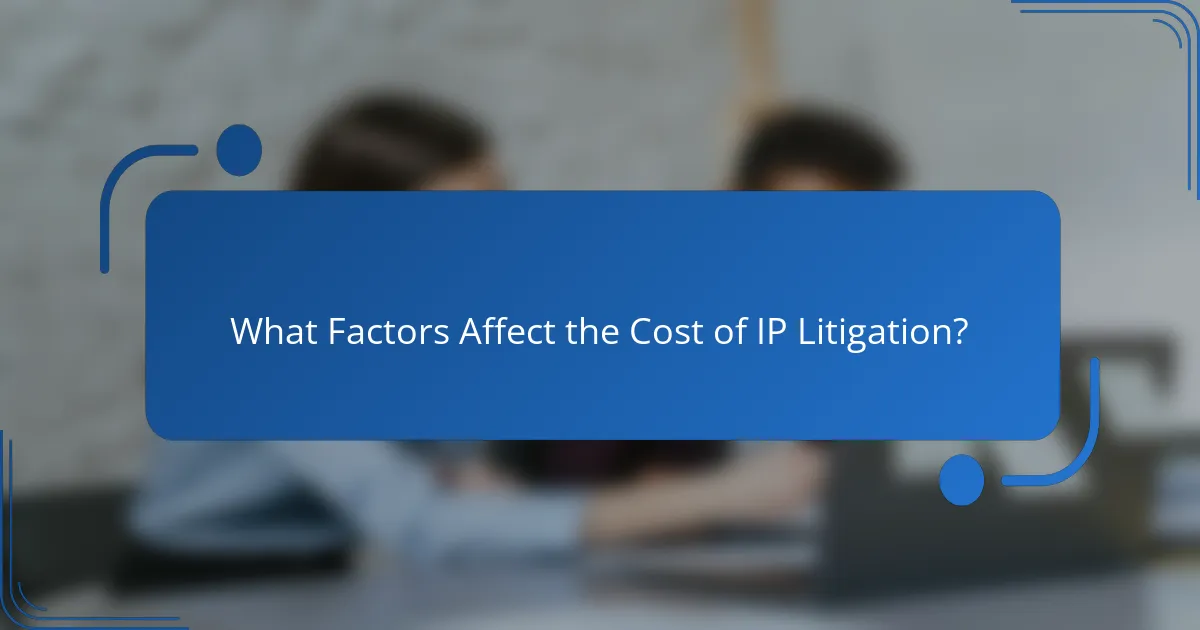
What Factors Affect the Cost of IP Litigation?
The cost of intellectual property (IP) litigation can vary significantly based on several key factors. Understanding these factors can help businesses and individuals estimate potential expenses and make informed decisions about pursuing legal action.
Type of intellectual property involved
The type of intellectual property at stake plays a crucial role in determining litigation costs. For instance, patent litigation is often more expensive than trademark or copyright disputes due to the complexity of patent laws and the need for expert witnesses. Costs can range from tens of thousands to millions of dollars, depending on the IP type and the nature of the infringement.
Additionally, certain industries may face higher costs due to the specialized knowledge required. For example, technology and pharmaceuticals often incur greater expenses in IP litigation compared to other sectors.
Jurisdictional influences
Jurisdiction can significantly impact the cost of IP litigation. Different countries and regions have varying legal frameworks, court fees, and procedural rules that can affect overall expenses. For example, litigation in the United States may involve higher attorney fees and longer timelines compared to other jurisdictions.
Moreover, some jurisdictions are known for being more favorable to IP holders, which may influence the strategy and potential costs involved. It’s essential to consider the local legal environment when estimating litigation expenses.
Complexity of the case
The complexity of an IP case directly correlates with its cost. Cases involving multiple parties, extensive evidence, or intricate legal arguments typically require more resources and time, leading to higher expenses. For example, a straightforward trademark dispute may cost significantly less than a multifaceted patent infringement case that involves extensive discovery and expert testimony.
To manage costs effectively, parties should assess the complexity of their case early on and consider alternative dispute resolution methods, such as mediation, which may be less expensive than traditional litigation.
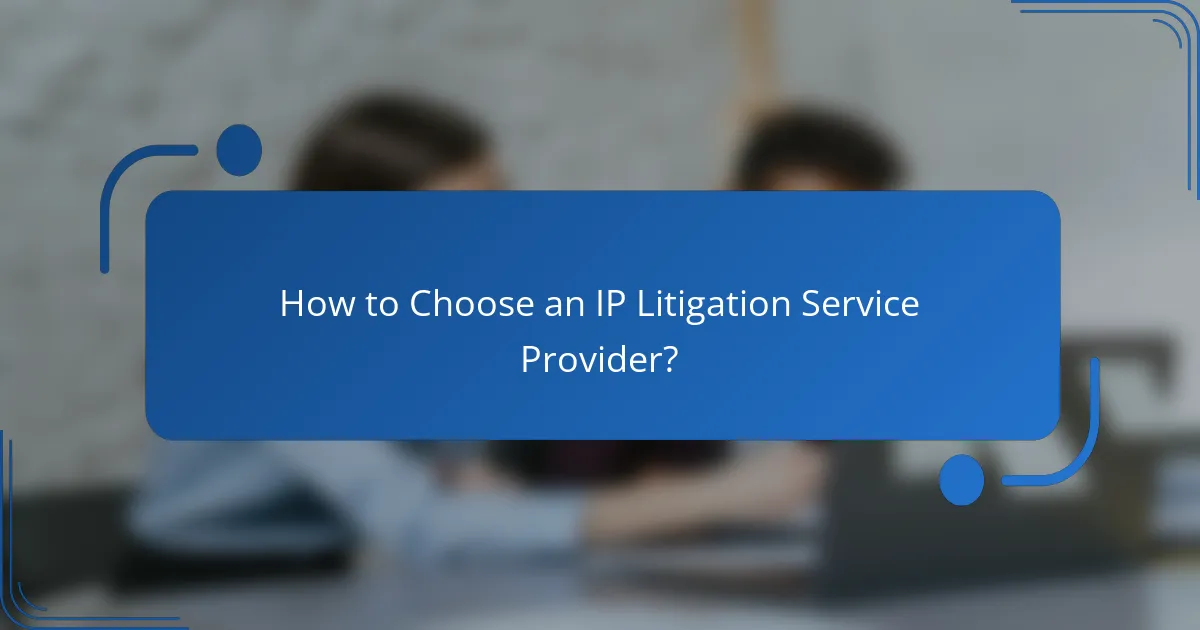
How to Choose an IP Litigation Service Provider?
Choosing an IP litigation service provider involves assessing their expertise, track record, and alignment with your specific needs. Focus on firms that specialize in intellectual property law and have a proven history of successful outcomes in similar cases.
Criteria for selecting a law firm
When selecting a law firm for IP litigation, consider their specialization in intellectual property, reputation, and client reviews. Look for firms that have handled cases similar to yours, as familiarity with specific industries can significantly impact the outcome.
Additionally, evaluate the firm’s resources, including access to expert witnesses and legal technology. A firm with a strong support system can enhance your case strategy and execution.
Importance of experience in IP law
Experience in IP law is crucial as it equips attorneys with the knowledge to navigate complex regulations and legal precedents. Firms with extensive experience are more likely to anticipate challenges and devise effective strategies tailored to your situation.
Consider firms that have been involved in high-stakes IP litigation, as their insights can provide a competitive edge. Experienced attorneys are also adept at negotiating settlements, which can save time and costs compared to prolonged litigation.
Evaluating success rates
Success rates are a key factor in choosing an IP litigation service provider. Look for firms that openly share their success metrics, such as the percentage of cases won or settled favorably. A firm with a high success rate in IP disputes can instill confidence in their capabilities.
However, consider the context of these rates; a firm may have a high success rate in specific types of cases but may not perform as well in others. Assessing their track record in cases similar to yours will provide a clearer picture of their potential effectiveness.
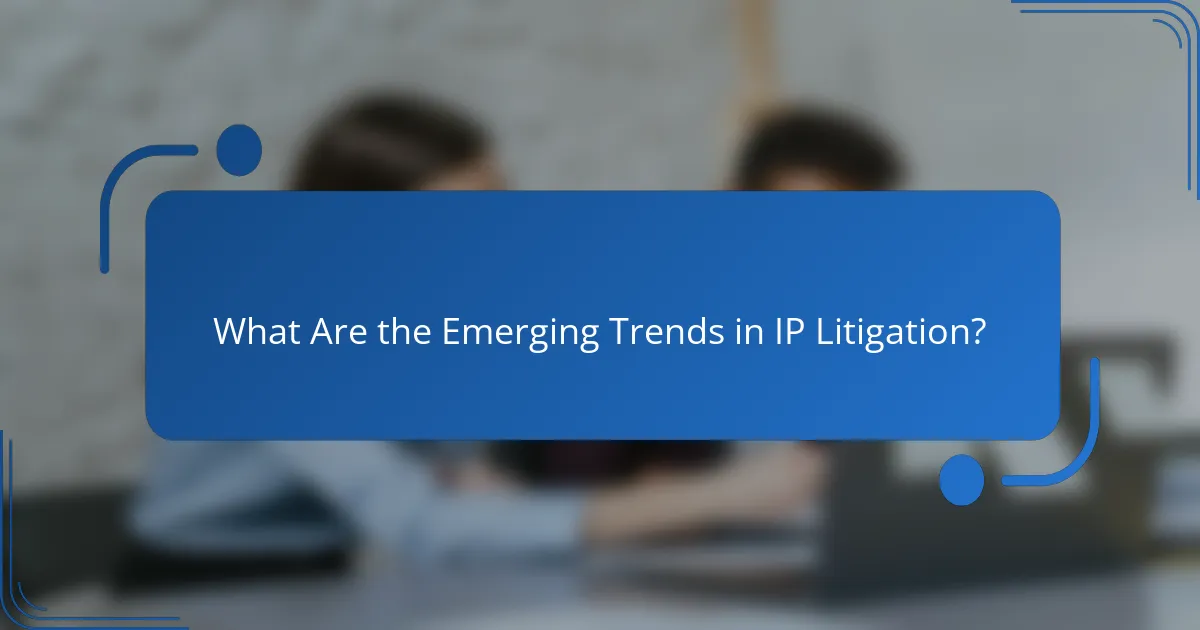
What Are the Emerging Trends in IP Litigation?
Emerging trends in IP litigation reflect the evolving landscape of technology, alternative dispute resolution, and cost management. These trends are shaping how legal professionals approach intellectual property disputes, with a focus on efficiency and effectiveness.
Impact of technology on litigation costs
Technology significantly influences litigation costs by streamlining processes and reducing time spent on cases. Tools such as e-discovery software and case management systems can lower expenses by automating document review and organization, potentially saving firms tens of thousands of dollars.
Moreover, the use of artificial intelligence in legal research and predictive analytics can help attorneys assess case outcomes more accurately, allowing for better strategic planning. Firms that adopt these technologies often find they can handle more cases with fewer resources, improving their overall profitability.
Trends in alternative dispute resolution
Alternative dispute resolution (ADR) is gaining traction as a cost-effective and time-saving method for resolving IP disputes. Mediation and arbitration can significantly reduce the duration and expenses associated with traditional litigation, often resulting in settlements that are reached in a matter of months rather than years.
Many companies are now incorporating ADR clauses into their contracts to encourage resolution outside of court. This approach not only minimizes legal costs but also preserves business relationships, making it a preferred option for many parties involved in IP disputes.
